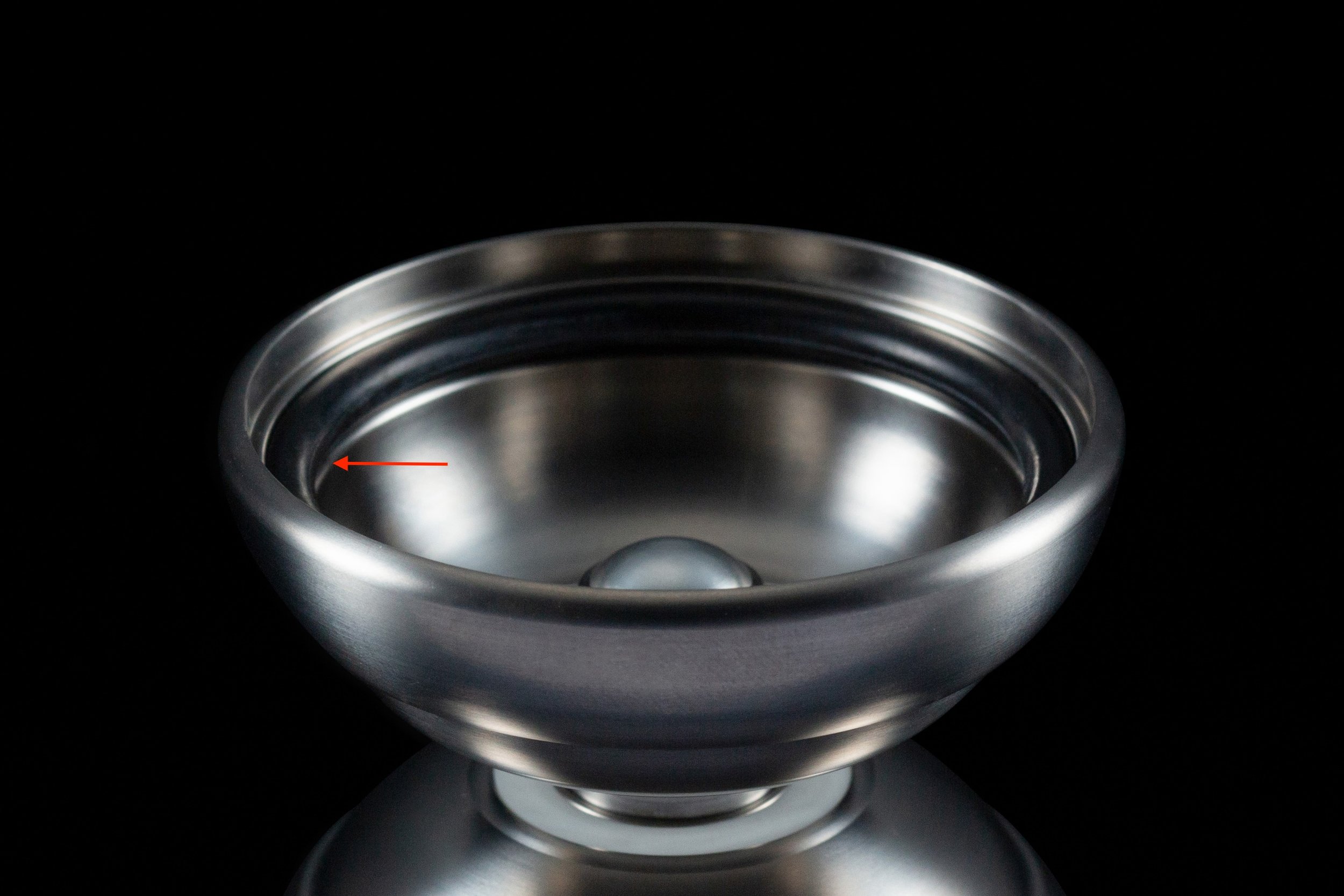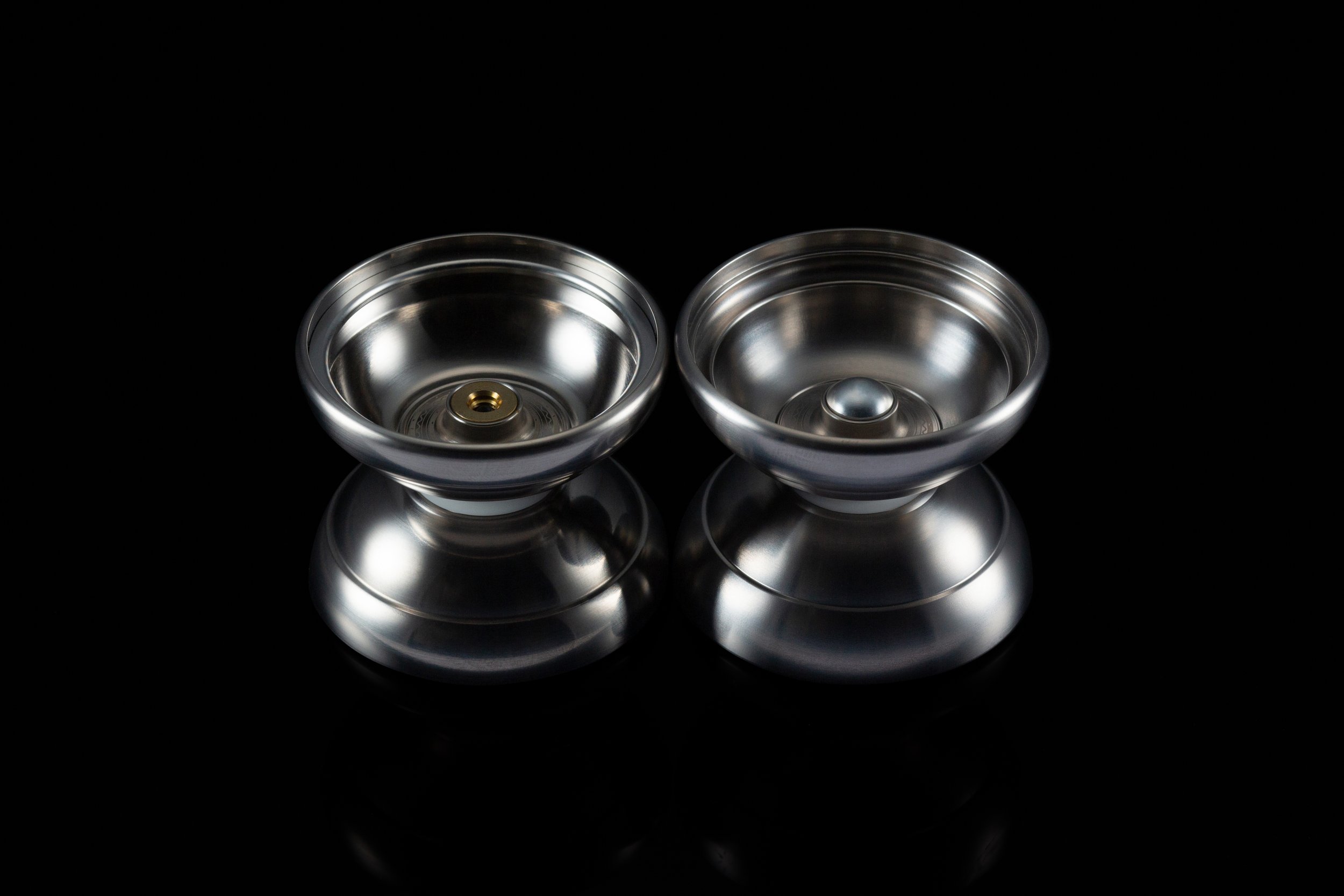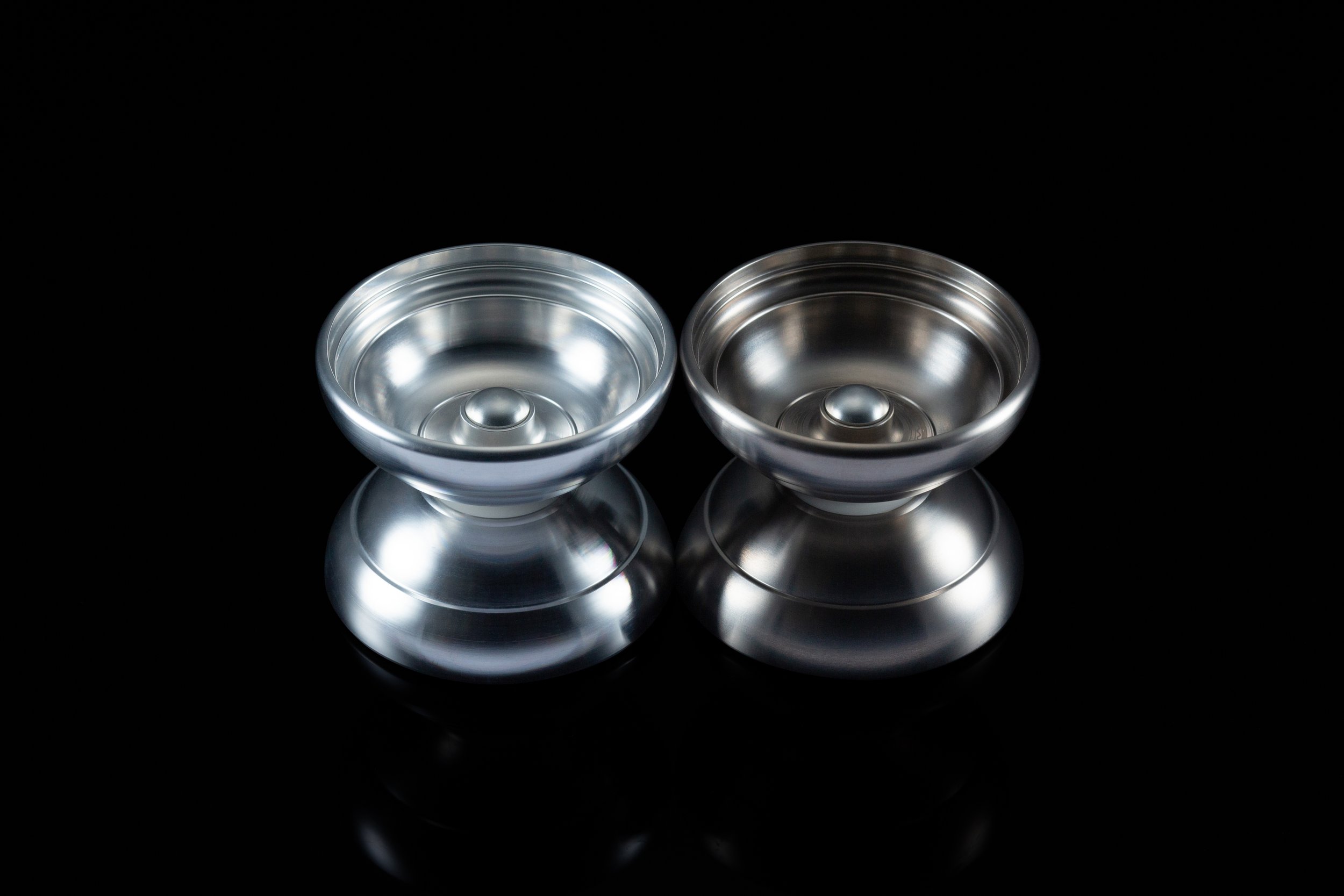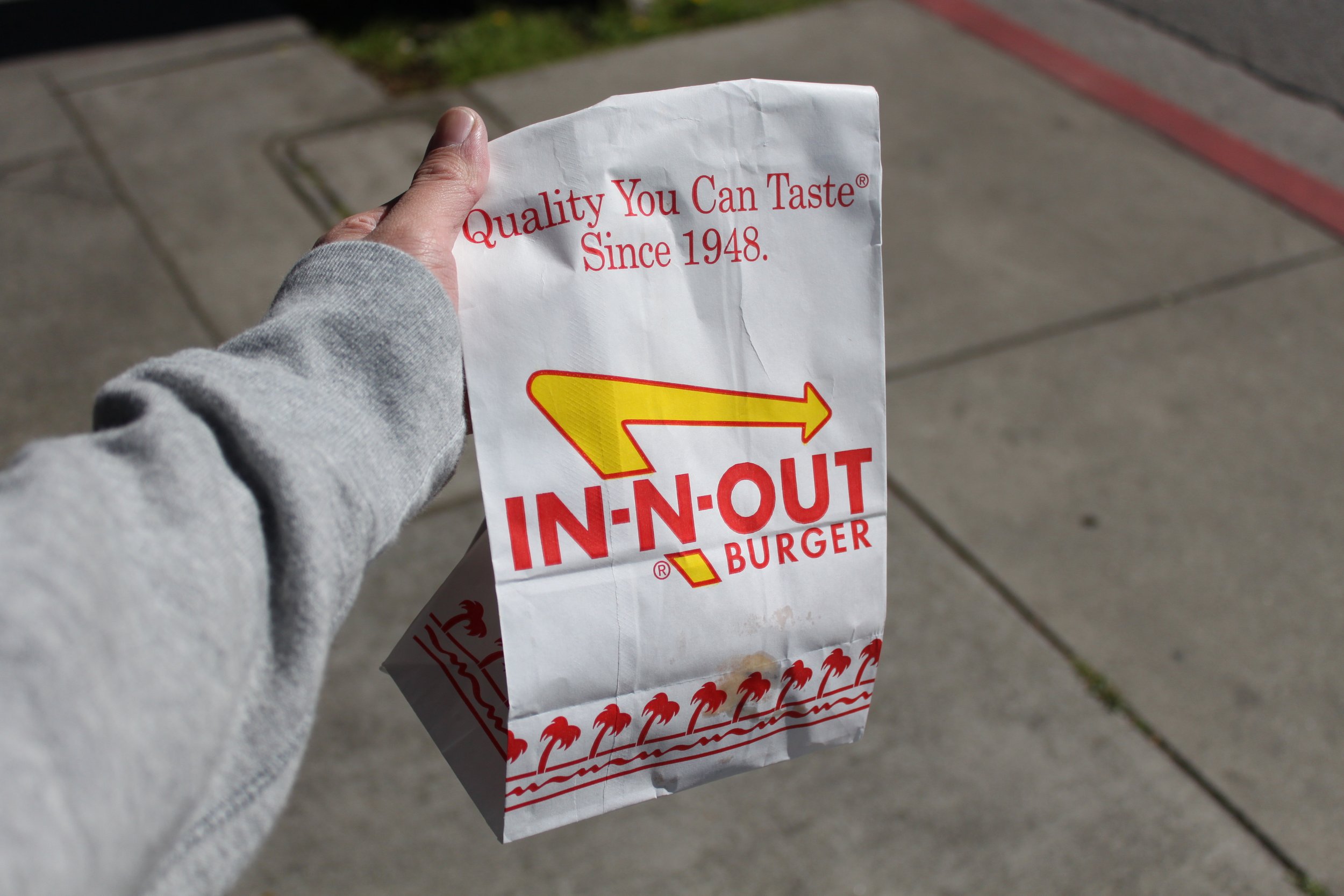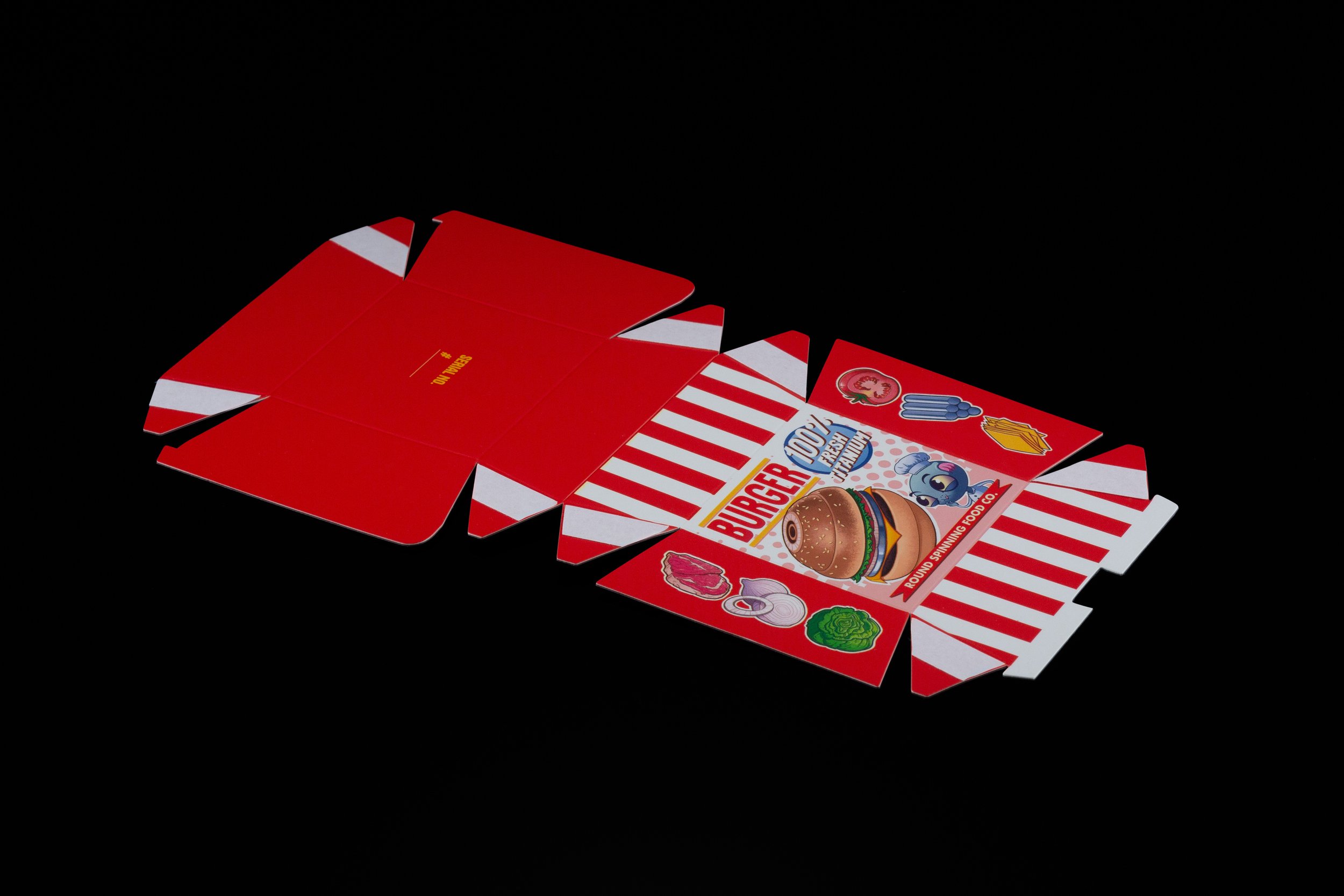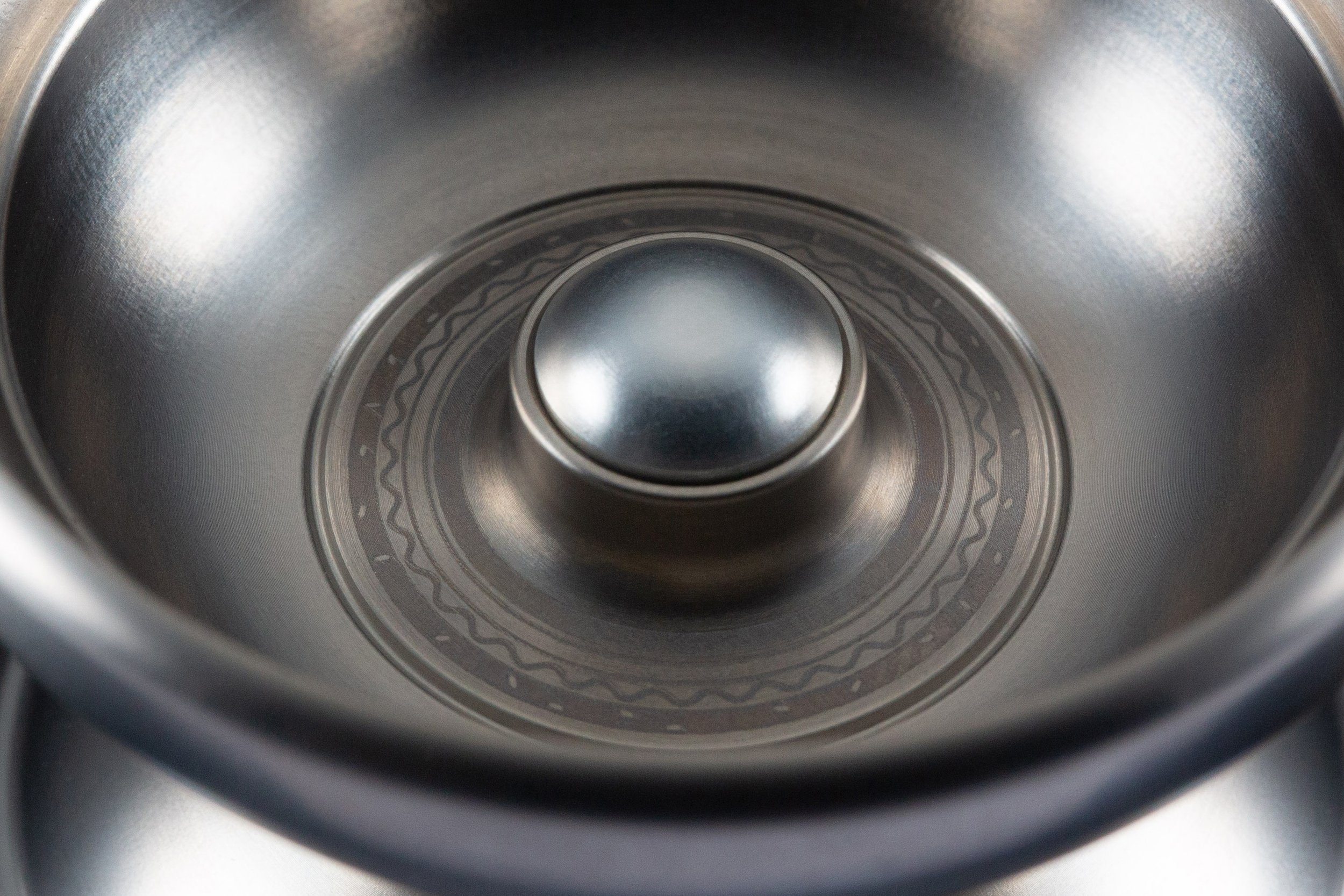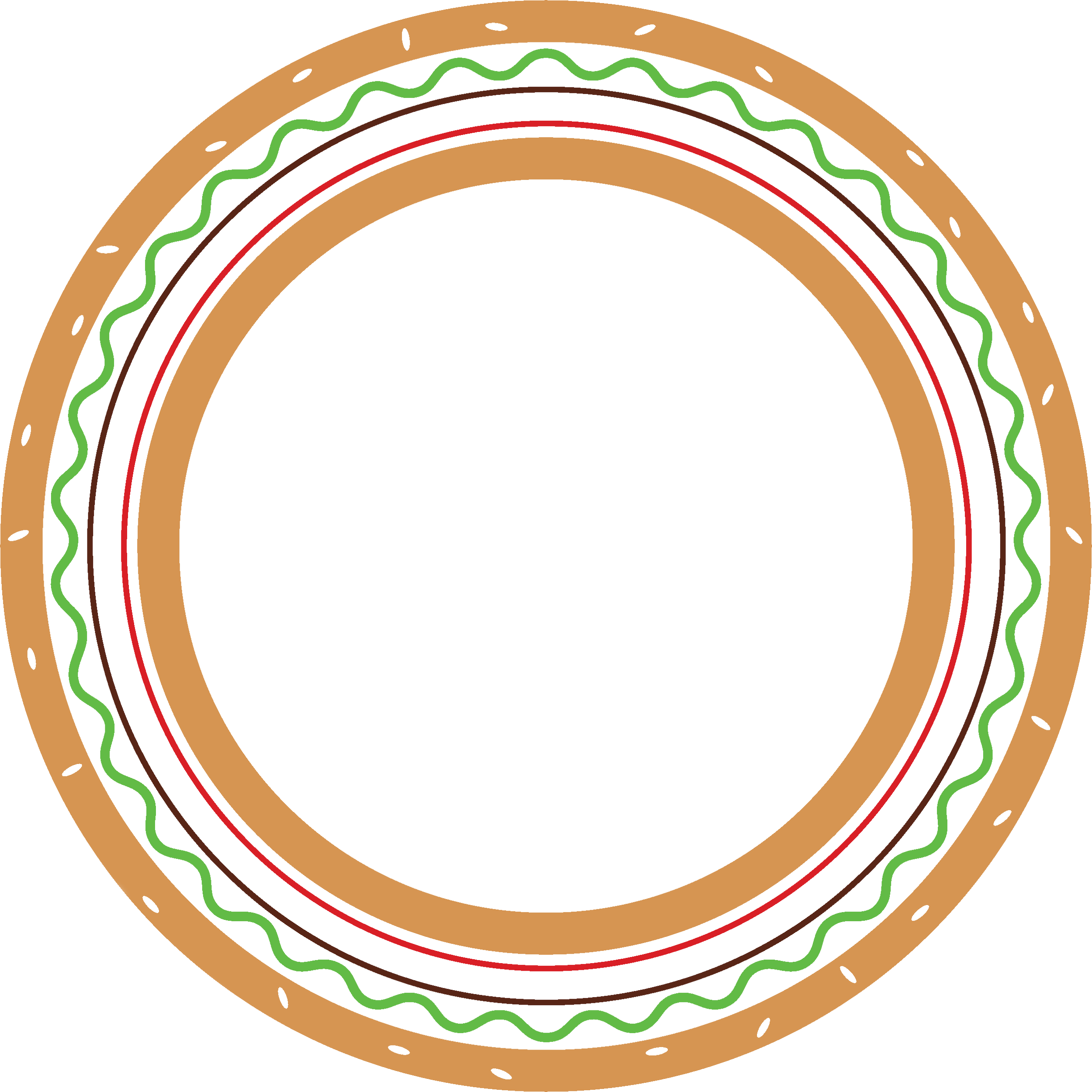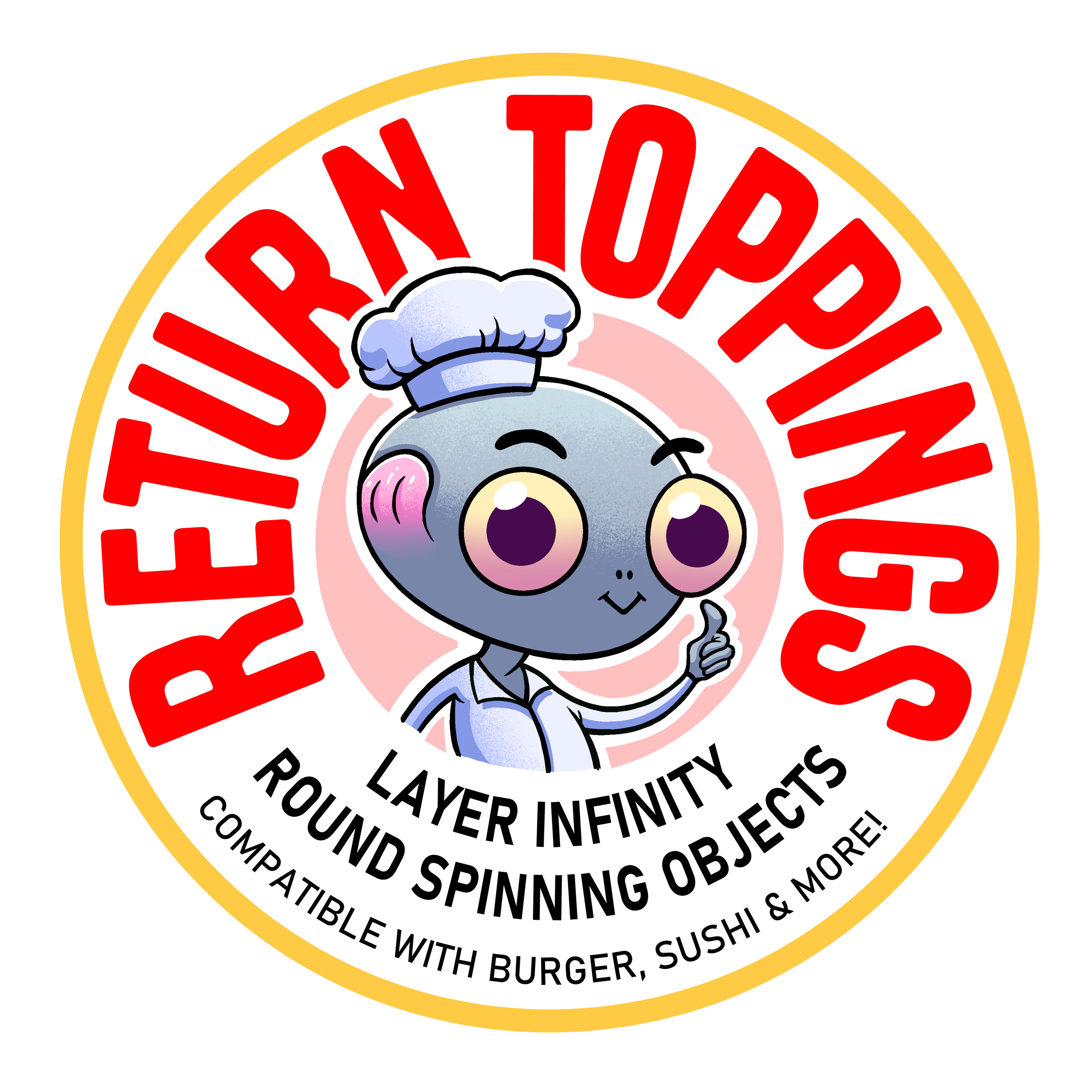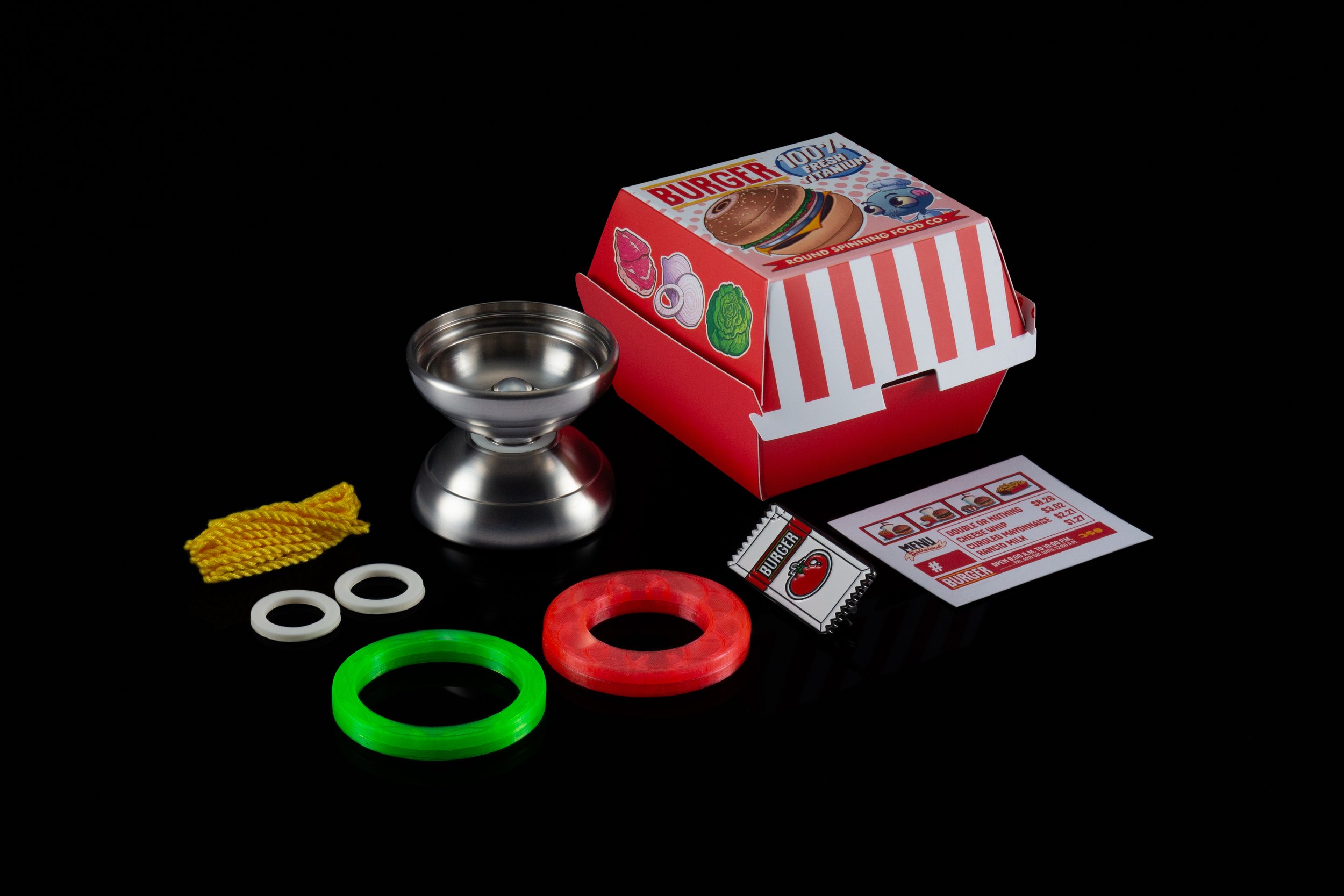RELEASE INFORMATION
Release DATE 2 DECEMBER 2023
Sold direcT AND VIA YOYOSAM, YOYOREWIND AND SPINGEAR
Retail 359.99 USD
RAW TITANIUM
60 MADE
SHIPPING WEIGHT OF 61.5g WITH ONE DROP ALUMINIUM DOME SIDE EFFECTS
Diameter 52mm, Width 42mm, Gap 4.4mm
YOYORECREATION NSK PLATINUM DOUBLE STRAIGHT C bearing
CLYW SLIM / G-GRIP SIZE TYPE 50 LANDING PADS RESPONSE
In my formative years, my family had a cherished tradition - most Sunday mornings were marked by pilgrimages to the McDonald's nestled by East Coast Park, followed by cycling trips by the beach. I would get a Happy Meal with an accompanying toy most weekends. Those outings were the highlight of my childhood, and the mere mention of the golden arches would light up my eyes with excitement.
Burger is THE Happy Meal for RSO fans.
FINGER LOOPIN’ GOOD
Burger’s catch zone draws inspiration from the VsNYYC Ti Walker (a titanium version of the Sky Walker) a "grail" revered by yo-yo enthusiasts worldwide as one of the best yo-yos ever made. While I've yet to personally experience the privilege of handling or possessing a Ti Walker, my collection proudly includes all three colourways of the Ti-Vayder. The Ti-Vayder is a 2019 brainchild of codinghorror that closely emulates the Ti Walker through the marvels of 3D scanning. While not precisely identical, particularly due to a modernized response system among other changes, it bears a striking resemblance. Unlike illicit knockoffs which had been floating around on the market, the Ti-Vayder project received belated blessing from its original designer, Heath Vizier, the creator behind VsNYYC.
Fun fact: Following the launch of the Ti-Vayder, I reached out to Heath on Facebook inquiring about the possibility of a re-run of the Ti Walker in its original form. However, he told me that he had promised to never to reproduce it.
The Ti Walker is a blend of elements from V and H shaped designs. It deviates from a pure V-shaped design with the inclusion of a step in the catch zone, imparting an H-shaped aesthetic. The inclusion of this step serves to distribute weight towards the rim of the yo-yo. Some players might aptly describe its form as resembling a W shape. There are yo-yos featuring a comparable shape to the Ti Walker. The Yoyofactory Skyline closely resembles it, whereas the sOMEThING Anglam takes on a steeper design.
Ti-Vayder (red) superimposed on a Yoyofactory Skyline.
Ti-Vayder (red) superimposed on a sOMEThING Anglam.
Cross section of the Ti-Vayder obtained from the YoYoExpert Forum (red) superimposed on a 3D render of Burger.
Burger is a "puffy" homage to the Ti Walker, reminiscent of the love handles adorning the Michelin Man (who also coincidentally resembles someone who indulges a bit too much in fast food). A more medially positioned step and pronounced curvature to the Burger catch zone transforms the overall shape of the yo-yo into an organic O-shape. The design process mirrors the delightful experience of coaxing bread dough to rise, except in yo-yo form. The Burger has a slightly smaller diameter than the Ti-Vayder, featuring a diameter of 52mm as opposed to the Ti-Vayder's 53.5mm.
Comparing their cups, the Burger and Ti-Vayder are worlds apart. The shallow groove around the Side Effects (SE) hub is an instantly recognizable RSO design element, familiar to players who own SE releases like Gravity and Droid.
Clockwise from top left: Sushi, Gravity and Burger.
Perhaps the most crucial distinction lies in the rims of the yo-yos. The Ti-Vayder's substantial rim weight is predominantly concentrated at the farthest edges of the rims, whereas the Burger's is slightly more centralized, approximately 6-7mm from the outer rim, just at the groove where the rubber O ring is placed. This is the same rubber O ring that fits the Silver Bullet Titanium, Gravity and Sushi.
As of this writing, only Reuben Ng from Atmos Projects and Wayne Ngan from Layer Infinity have had the opportunity to play the production Burger. Both were assigned the task of conveying Burger's playfeel. In comparison to the Ti-Vayder, it exhibits a less aggressive playstyle and is more responsive to changes in direction. Weighing in at just 61.5g with aluminum dome SE (in contrast to the Ti-Vayder's 63.7g), Burger’s presence on the string feels almost "airy," and when cradled in the hand, the yo-yo offers a sensation reminiscent of holding a fluffy bun. The larger diameter CLYW / G-grip Landing Pads give Burger a greater initial momentum on the throw.
The concentration of rim weight at this groove was achievable solely due to the presence of a single step in the catch zone, a luxury that I did not have when designing Gravity and Sushi.
The groove on Burger which accommodates the rubber O ring (red arrow), is where most of the weight is concentrated.
This design feature allowed for preservation of a rim-weighted distribution while at the same time allowed for the yo-yo to accommodate Duncan Freehand caps. Note that Burger will NOT accommodate the custom polycarbonate caps and rings that were included with Gravity and Sushi.
We note that players rarely played the Gravity or Sushi with Freehand caps. As such, Burger will not ship with a cap removal tool. However, it will be available for separate purchase if needed.
HEAVEN IN A BURGER
RSO had Burger in the oven back in October 2021, after Sushi was wrapped. Following the remarkable success of Gravity, my objective was to craft a trio of yo-yos that could be personalized with caps/rings and SE. Like the development of Sushi, the creation of Burger extended beyond the anticipated timeline due to an extensive prototyping process. Perfecting the design has been a two-year-long endeavor.
From left to right: first prototype, second bimetal prototype, third aluminium prototype, production version.
The CAD for Burger was finalized on the last week of November 2021 and the first prototypes reached me 2 weeks later. At that time, it was named Astronaut as its catch zone reminded me of the bulky space suits (I am now using this name for a different yo-yo). Entirely by coincidence, I noticed soon after that a Japanese yo-yo player (@sho1_leatheryoyoshop_fe) had independently conceived a design akin to Burger. I contacted him via Instagram, sharing an image of Burger, specifically focusing on the catch zone. To our amusement, he echoed my sentiments, acknowledging the catch zone similarities while pointing out distinct differences in other design aspects. To my knowledge, his design did not progress to the production stage. The serendipitous nature of this encounter makes it worth sharing.
The first Burger CAD was conceived on 24 November 2021. At that time, it was named Astronaut. The catch zone shown had undergone further changes - it was made rounder and the single step placed more medially - before arriving at the first prototype. This screenshot has been redacted.
A post by @sho1_leatheryoyoshop_fe on Instagram dated 22 December 2021. He had no prior knowledge of Burger (or Astronaut at that time).
Over the ensuing years, the first prototypes found their way to a few RSO customers. The general consensus was that a notable drawback of the first prototype was its insufficient rim weight. Even with aluminium ultralight SE installed, it felt like a rock on the string.
First prototype (left) and production version (right). Notice the more pronounced groove for the rubber O ring on the production version.
My first instinct to add more rim weight was to incorporate steel rings, making Burger a bimetal Titanium-Stainless Steel (TiSS) yo-yo. I felt highly confident in its feasibility, having previously launched a highly smooth batch of Droids, another TiSS yo-yo with SE. Although the effort saw some success, allowing most halves to be eventually tuned for smoothness—an accomplishment challenging with any TiSS SE yo-yo—the playfeel of the TiSS Burger ultimately fell short of expectations.
Undecided on this prototype, I spent a whole year testing it. Considering the significant investment I had already made in the prototypes, I wanted to ensure I was making the right decision moving forward. I even enlisted Reuben from Atmos Projects to try it out.
Ultimately, the prototype felt overpowering, lacking soul and the “fluffy” movement signature reminiscent of a burger bun that I had envisioned. Its playfeel didn't align with its appearance. Given the required selling price for the TiSS Burger, I felt it was unworthy of production and was compelled to return to the drawing board.
Second bimetal TiSS prototype (left) and production version (right).
Second bimetal TiSS prototype (left) and production version (right).
Second bimetal TiSS prototype. Although the groove for the rubber O rings were removed, the rubber O rings could still be placed snugly under the steel rings. Freehand caps would sit on top of the steel rings.
The final prototype played like a charm and perfectly embodied my vision for Burger. With the first prototype CAD as a starting point, weight was redistributed more peripherally to the groove which accommodates the rubber O ring. This brought just the right amount of weight to the rim, less so than the stainless steel rings of the TiSS prototype, effectively addressing the problems posed by the initial two prototypes.
Significant rim weight was added to the rubber O ring groove of the first prototype (red arrow), with a deeper groove on the production version (green arrow).
As with Droid, an additional aluminium prototype, along with a third titanium one, was made before commencing mass production to address any potential issues. Fortunately, the assembly process for Burger proved to be much simpler than Droid, thanks to its monometal nature.
Aluminium prototype (left) and production version (right).
FLAVOR MEETS THE STRING
The Burger artwork draws inspiration mainly from In-N-Out, which is (sadly) only available in the U.S. I've had the privilege of visiting the U.S. twice in my life—first in 2007 for a family holiday in San Francisco and Las Vegas, and later in 2010 for a month-long medical elective at the Ronald Reagan UCLA Medical Center as a medical student.
In-N-Out located at Mountain View, CA, in 2007.
Inside the In-N-Out restaurant, which doesn’t seemed to have changed much since 2007 comparing with recent photos on Google Reviews.
My younger brother and late father enjoying their In-N-Out cheeseburgers in 2007.
One particularly cherished memory revolves around the In-N-Out cheeseburger. Throughout my elective at UCLA, I made it a routine to purchase a cheeseburger on Gayley Avenue almost every day on my way home… for an entire month! Looking back, perhaps indulging in so much fast food wasn't the healthiest choice, but I truly savored every bite of that burger!
I spent a month long attachment with the liver transplant team at the Ronald Reagan UCLA Medical Center in 2010. I eventually did not choose a surgical residency and I am now an interventional radiologist.
In the hospital changing room.
Setting off for work from our apartment we rented in Beverly Hills.
Many trips were made to the In-N-Out restaurant at Gayley Avenue, LA, on my way home from the hospital.
The Burger artwork was done by ATILA. The dominant color palette of the artwork closely mirrors the red hue of the In-N-Out logo. Burger would not be complete without a mini burger box, with Burger ingredients on the side flaps (noticed the titanium bars?) The certificate takes design cues from the In-N-Out menu, while its ketchup sachets were referenced for the pin.
To infuse a touch of McDonald’s aesthetics, a hint of yellow was incorporated. McDonald’s is my favorite fast food chain.
The custom burger box that ships with Burger is slightly smaller than a real life burger box.
This write up would not be complete without obligatory shots of Burger… in its burger form.
Engraving showing different layers of a burger.
HAVE IT YOUR WAY
RSO has collaborated with Layer Infinity to offer fellow fast food enthusiasts two weight rings we have affectionately named Return Toppings: Lettuce and Tomato. The Lettuce Return Topping weighs approximately 1.8g each, while the Tomato variant weighs 2.7g each. When paired with aluminum dome SE, Burger will have a weight of 65.1g and 66.9g, respectively. Each Return Topping features a pattern reminiscent of the vegetable that inspired its name. These weight rings are also compatible with Gravity and Sushi.
“These weighty rims—delectably named "Return Toppings"—are 3D printed with a process similar to my other products like Crystal rims and Kasm. The translucent face reveals the actual structure inside, with one significant difference. While the patterns on Crystal rims and Kasm were computationally generated as infill by the slicer software, Return Toppings' patterns are actually part of the CAD model itself. This way, the pattern can be as detailed as the printer's resolution allows.
3D printing with translucent filament poses an interesting challenge. The goal is for the initial layer to be as clear as possible for the internal structure to show up. This process is very sensitive to machine settings like layer height, temperature, and filament retraction, which differ from those used in printing ordinary opaque objects. Combined with size and mass calibrations, Return Toppings required a small mountain of prototypes just to determine the ideal settings for production.
This run of Return Toppings is designed to resemble two ingredients you'd find in burger sandwiches: Lettuce and Tomatoes. While the Lettuce (1.8g each) provides a comfortable balance between rim weight and zippiness, the Tomatoes (2.8g each) are noticeably heavier and more powerful.
What type of Return Toppings would you like in your Burger?”
- Wayne Ngan, Layer Infinity
These stickers were crafted for Burger. Feel free to print them (with a diameter of 48 mm) and stick them on the caps that came with Gravity and Sushi!














